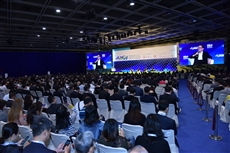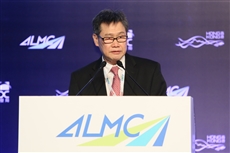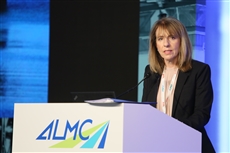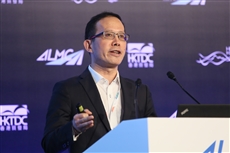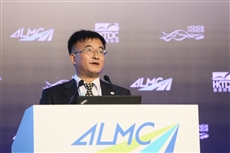Asian Logistics and Maritime Conference
21 November 2018 – The Asia-Pacific region is growing rapidly despite uncertainty related to the trade conflict between Mainland China and the United States. Hong Kong continues to be a key trading and logistics hub linking the mainland, Association of Southeast Asian Nations (ASEAN) members and global markets through its excellent regional and global sea and air links. The eighth Asian Logistics and Maritime Conference, organised by the Hong Kong Trade Development Council (HKTDC) and Hong Kong Special Administrative Region Government, held on 20-21 Nov, brought together logistics industry players from across the region and the world.
ASEAN Committed to Enhanced Regional and Global Connectivity
H.E. Dato Lim Jock Hoi, Secretary-General of ASEAN, delivered the keynote address at the opening session yesterday. He pointed out that ASEAN is now the sixth-largest economy in the world, with a combined GDP (gross domestic product) of US$2.8 trillion. The region continues to grow at a tremendous pace, owing to free trade, the liberalisation of logistics and trade services, enhanced transport, and expanded trade routes, he said. The challenge is to upgrade ports and build a more efficient maritime, highway and rail network to provide a more balanced infrastructure, Mr Lim said, adding this will require substantial infrastructure investment. “ASEAN is committed to enhanced regional and global connectivity,” he emphasised, “but we need sustainable solutions to infrastructure to provide greater connectivity.” Hong Kong is a strategic partner in enhancing ASEAN’s logistical efficiency, he concluded.
The discussion in Plenary Session 1 under the theme “Boosting Asian Connectivity for a New Regional Economic Order”, focused on changes in transportation trends and logistics technology, challenges in highway and rail infrastructure, and opportunities for Hong Kong to maintain and enhance its role as a regional transportation and logistics hub.
Connectivity Key to Growth
“Asia is a strong, resilient trading bloc in a globalised world, and connectivity is the key to global growth,” said Karen Reddington, President of the Asia-Pacific Division of FedEx Express. She suggested three ways to build on this connectivity. One is to keep trade as open as possible. Confident countries lower their trade barriers and do more business as a result, with economies and companies prospering, she said. “Asia is embracing free trade because it is confident.”
The second way to build connectivity is to provide businesses with the right digital expertise to grow their footprint, and with environmental knowledge and awareness to improve efficiency, while enhancing the environmental sustainability and safety of cities.
The third critical factor in building connectivity is to develop infrastructure to accelerate and support growth. This requires policy makers to have long-term foresight, since infrastructure must be five to 10 years ahead of growth, she explained. Infrastructure must be efficient and technologically advanced, with risk-management integrated into it at all levels. It is estimated that annual investment of US$3.3 trillion will be required just for current growth. “Connectivity is the key to global growth,” Ms Reddington concluded. “We must keep connecting and integrating to maintain the momentum.”
Boosting Connectivity
“The logistics and transport industry must adapt to fast-changing demand from customers,” Mike Fang, Vice President and Head of Greater China for Maersk Line, told the plenary. “We must connect and simplify supply chains.”
The massive scope of the Belt and Road Initiative has led to the rise of intercontinental rail transport, he explained, not to replace sea transport, but to supplement it. Rail is one-third the cost of air freight and produces 90% less carbon emissions. Rail transport to Central Asia and Western Europe is much faster than sea freight. Rail from Wuhan to France, for example, takes 20 days, compared with 30 days by sea.
Maersk has a number of initiatives to boost connectivity, he explained. Asia has 20 of the world’s largest ports, so there are opportunities for improved terminal planning for both the land side and marine side, with the goal of reducing costs and generating more revenue from the port ecosystem. Intra-Asia trade is among the world’s largest and fastest-growing trade areas, he said.
Maersk has a number of digital initiatives in the pipeline to improve customer service, reduce costs, improve asset productivity and develop new revenue sources, he said.
“Improving connectivity requires all players in the end-to-end supply chain to cooperate to be relevant to customers in the future,” Mr Fang concluded.
Rise of Intercontinental Rail Transport
“Rail is becoming an important alternative for shipping goods from all parts of East Asia to Central Asia and even Europe,” said Zhong Cheng, Deputy General Manager of China Railway Container Transport Corp Ltd. (CRCT), “because it is much cheaper and more environmentally friendly than air transport and more time efficient than sea transport.”
CRTC developed quickly, he explained, starting in 2011, with growth of 10% a year, in line with the Belt and Road Initiative. CRTC’s transport corridors basically follow the original Silk Road. CRTC has three main rail corridors from 50 cities in the mainland to the West: one to Central Asia and Europe, one to Mongolia and Russia, and one through the mainland and Russia. Rail can deliver goods to Europe 10 days faster than sea transport. CRTC continually seeks ways to optimise transport solutions. It is improving documentation support and has added 60 rail service points in Europe, and enhanced collaboration with 70 countries, forming joint working groups to find ways to improve delivery, Mr Zhong said.
CRTC is also developing in the Asia-Pacific. It has signed a cooperative agreement with Vietnam, which will use the firm’s southern corridor to Central Asia and Europe. And CRTC has worked successfully with Korea and Japan to use CRTC’s rail corridors to replace sea transport to Central Asia.
The way forward for CRTC, he said, is firstly to take advantage of technology developments to reduce costs and improve efficiency, secondly to develop more rail corridors, especially to southern Europe, thirdly to enhance information exchange with customs agencies in each country to reduce clearance times and fourthly to enhance transportation safety. “We look forward to developing win-win relationships and more synergies with our colleagues here,” Mr Zhong concluded.
What is Hong Kong’s Future as a Logistics Hub?
At the Question & Answer Session, speakers were asked to address Hong Kong’s future role as a logistics hub is. Mr Zhong pointed out that Hong Kong was Asia’s maritime and logistics centre, especially for re-export. Ms Reddington said that Hong Kong was FedEx’s headquarters for Asia Pacific for good reason. “It is already the world’s largest air cargo hub, but it is not resting on its laurels, building a third runway.” Hong Kong also has a good regulatory system, she said. Mr Fang said Hong Kong is Maersk’s registered office for Asia. He pointed out that in addition to excellent infrastructure, Hong Kong had the full range of support services for shippers and logistics companies
|
|
Among the highlights of the Asian Logistics and Maritime Conference (ALMC) was yesterday’s plenary session, “Boosting Asian Connectivity for a New Regional Economic Order”, which examined opportunities and challenges presented by closer regional cooperation and integration. Speakers included Karen Reddington, President, Asia Pacific Division, FedEx Express; Mike Fang, Vice President, Head of Greater China, Maersk Line; and Zhong Cheng, Deputy General Manager, China Railway Container Transport Corp Ltd |
|
|
H.E. Dato Lim Jock Hoi, Secretary-General of ASEAN, delivered the keynote address at the opening session on 20 Nov |
|
|
Karen Reddington, President, Asia Pacific Division, FedEx Express |
|
|
Mike Fang, Vice President, Head of Greater China, Maersk Line |
|
|
Zhong Cheng, Deputy General Manager, China Railway Container Transport Corp Ltd |
|
|
More than 70 experts and leaders from the logistics and maritime industries are speaking at the eighth edition of ALMC, which opened yesterday at the Hong Kong Convention and Exhibition Centre. The two-day conference was jointly organised by the Hong Kong Trade Development Council and the Government of the Hong Kong Special Administrative Region |
|
Fair website: |
|
|
Speakers: |
|
|
Programme: |
www.almc.hk/en/info_programme.html
|
Media Enquiries
Please contact the HKTDC’s Communication and Public Affairs Department:
Sunny Ng Tel: (852) 2584 4357 Email: sunny.sl.ng@hktdc.org
Christine Kam Tel: (852) 2584 4514 Email: christine.kam@hktdc.org
To view press releases in Chinese, please visit http://mediaroom.hktdc.com/tc
About the HKTDC
Established in 1966, the Hong Kong Trade Development Council (HKTDC) is a statutory body dedicated to creating opportunities for Hong Kong’s businesses. With 50 offices globally, including 13 in Mainland China, the HKTDC promotes Hong Kong as a platform for doing business with the mainland, Asia and the world. With more than 50 years of experience, the HKTDC organises international exhibitions, conferences and business missions to provide companies, particularly SMEs, with business opportunities in the mainland and international markets, while providing business insights and information via trade publications, research reports and digital channels including the media room. For more information, please visit: www.hktdc.com/aboutus.


